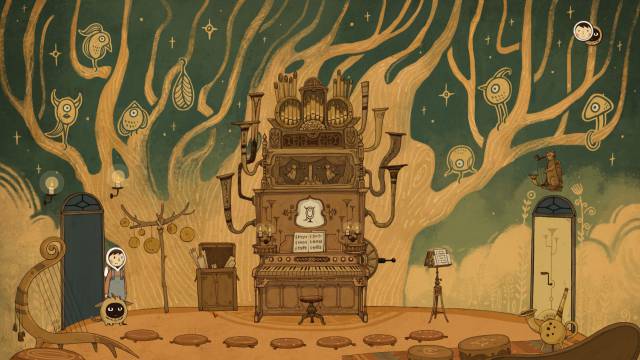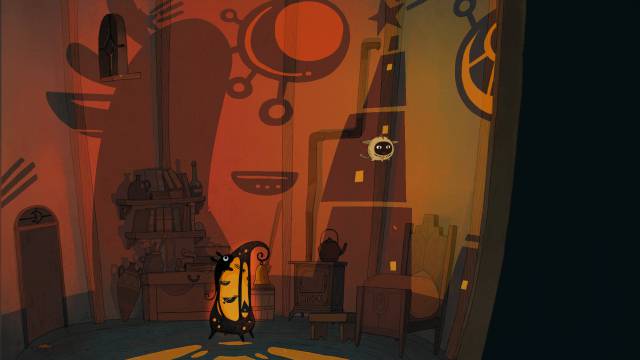
We analyze this beautiful fable in the form of masterful graphic adventure at audiovisual level.
The increasingly flourishing independent sector of the video game does not stop giving us joys and surprises to each passing day. On this occasion, we find a small audiovisual delight in the form of a graphic adventure with a really sweeping staging. Behind this more than attractive game is the modest novel Lantern Studio, originally from distant China. Its members are the artistic director Beidi Guo, Fox as project manager, Wang Guan programmer with experience in several Ubisoft titles, and Wang Qian as composer of the entire sound section. The original idea of the title goes back to far more than 2007, when Beidi produced a short animated student about a man who pilots the Moon around the Earth. With this short as inspiration and reference, they created a small conceptual demo of the work they had in mind, and after moving them in various circles of the sector, they decided to launch a financing campaign in Kickstarter to be able to get their work forward. Due to their labor obligations, the team members dispersed across the globe and the development of the title suffered, until finally in 2017 they decide to put all the meat on the grill and leave their jobs to devote themselves entirely to finalizing their promising graphic adventure .
One of the main sources of inspiration for Luna: The Shadow Dust was the work of the famous American science fiction writer Ursula Kroeber Le Guin, specifically the works belonging to the Terramar cycle. Far from treating the already well-fought fight between good and evil, the title speaks of the balance between the two. For the promotion of the game, the phrase “lighting a candle means invoking a shadow” has been used, a sentence belonging to one of the novels of the Terramar cycle mentioned. When listing the inspirations received from the videogame sector, the creators of the title mention the 90's classic The Neverhood, as well as the most recent Machinarium and the Samorost trilogy of our revered Amanita Design, along with the superb Gorogoa puzzle game . Almost nothing for a novel studio that presents its first work.
The other great influence mentioned is more than evident. And is that if something stands out Luna: The Shadow Dust is for its majestic staging, with a delicious visual section, very hardworking and really beautiful and evocative, and that inevitably reminds us of the work of that inexhaustible source of fantasy and magic that It is the Ghibli study. The pleitesia that the creators of this work feel for the study of the genius Hayao Miyazaki and company is noted. Each screen leaves us prints of admirable quality and beauty, with a work of titanic animations, and with a series of fantastic animated sequences created with great care and dedication. The work of artists Shaun Tan and Jean Giraud are also named as a source of inspiration for a really attractive visual section.
So, we are facing an attractive visually sweeping graphic adventure, which offers us a story told without absolutely any line of dialogue, and that offers us a seasoned development of emotional cinematic scenes that seek to imitate the sensations left by the filmography of the studio Ghibli .
The balance between light and dark
At the beginning of the adventure, in an introductory sequence that already begins to show off all the audiovisual benefits that we have commented, we see a young man falling into the void from a great height, being saved at the last moment by a mysterious light. After some bewildered first steps, we see how before him stands a mysterious and dark tower of Herculean proportions. To reestablish the balance lost in the magical world where the adventure takes place, our intrepid protagonist must reach the top of the tower to return the moon to its place in the sky and return order to the world. Shortly after entering the tower you will find a faithful ally, in the form of a curious four-legged furry animal, which will be inseparable.
We must highlight the risky narrative commitment of the game, absolutely denying any form of text or dialogue. Everything that is told in the game is done through spectacular and beautiful cinematic scenes, and through the stages themselves. This bet meets more than enough to tell us an emotional and epic story of courage as we accompany our intrepid duo to unravel the dark mystery behind this mysterious tower at the edge of the end of the world.

Amanita style graphic adventure
On a playable level, we are facing a point and click adventure that largely follows the guidelines set out in the titles of the great Czech studio responsible for Machinarium or the Samorost trilogy, these being a source of inspiration for the creators of this adventure as we already mentioned paragraphs further back. The contextual pointer used to manage the title will take different forms for the actions of walking or interacting, and at all times we can alternate the control of the boy of unknown name or his furry and adorable companion, who must cooperate to solve many of the obstacles Let us find. Each floor of the tower will act as a closed puzzle in itself, so that it will limit the range of action, simplifying the resolution of each of them by being totally independent. We found a good variety of mechanics in the puzzles, but unfortunately nothing is deepened in each of them, leaving the feeling that the puzzles lack spark and depth.
This is especially disappointing with the mechanics of lights and shadows, which in addition to the narrative as part of the story, acquires vital importance as a playable mechanic for a couple of puzzles, but leaves the feeling that it could have deepened more in it and that gave to pose more interesting and complex puzzles. In addition, the approach of a pair of these puzzles is somewhat obtuse and makes it difficult to solve them for wrong reasons beyond the challenge they should offer, revoking that we get stuck in them without having to. At the level of playability and playable mechanics, Luna: The Shadow Dust offers competent performance but that is far from the greats of the genre, leaving the feeling that it could offer much more, especially that introduction of the play of light and shadow that remains in something merely anecdotal.

Unfortunately, we are not facing an excessively long title. The adventure lasted around 5-6 hours, and that we got stuck a couple of times due to the approach of some puzzle. In general, these puzzles are not complicated, and despite the short duration, it is enjoyed a lot while it lasts. As we have already mentioned, the game does not present any type of text, even in its menus, so you do not have to worry about the language to enjoy the adventure, since everything that is narrated here is done through an outrageously attractive audiovisual section.
Ghibli style audiovisual fantasy
The undisputed strength of the title of Lantern Studio is a superb and simple and plainly delicious visual section. The work put in the graphic section is titanic and wastes tremendous passion and pampering. Traditional animation work has been carried out image by image, with 12 images per second and 3 layers per image. The artistic direction, unequivocal debtor of the work of Mr. Miyazaki's studio, is superb and captivates an attractive animated fable on screen as few. The recreation of the scenarios, the level of detail and the imagery of which they show up turn out to be a gift for the eyes. The color palette used is warm and very successful, reflecting in a wonderful way that dichotomy between light and darkness so inherent in the title itself. The cinematic scenes are another wonder, leaving epic, endearing and magical moments.

The soundtrack is not far behind, with evocative, emotional themes that know how to completely immerse the player in the adventure at all times. It is incredible to find a soundtrack of this entity, with so many nuances and so much quality, in a title of a modest independent team. The wrapping of this magical adventure could not be more attractive, and it has nothing to envy to much larger productions with infinitely more inflated budgets than the one that has told this beautiful animated fable of incomparable staging.
CONCLUSION
Luna: The Shadow Dust is an attractive graphic adventure focused on independent puzzles, which has a masterful packaging but unfortunately is not accompanied by a development and mechanics according to such deployment. Without doing anything wrong, he leaves the feeling that he does not deepen anything in his proposals, and that his mechanics gave for much more. It offers simply correct puzzles, some with a somewhat obtuse approach, and its duration is not excessively long. Despite this, its superb visual section, in the best tradition of the works of the Ghibli studio, its spectacular soundtrack and its emotional and immersive history make it a more enjoyable title if we are not very demanding with the puzzles it poses. It is a very good starting point for the study, in an enormously attractive title at a visual level, with a colossal work behind its graphic section, and that will catch us as we dive into its magical world.
THE BEST
- The visual section inspired by the works of the Ghibli studio is majestic and full of prints of enormous beauty.
- The soundtrack is of a very high level.
- Get to tell an emotional and epic story without using a single line of text.
WORST
- Almost nothing goes deep in their mechanics, with puzzles that could offer much more.
- There is some somewhat obtuse solution, with some interactions that could have been better implemented.
- The slowness of the characters is somewhat exasperating in certain situations.
- Its duration is short.
Good
It meets the expectations of what a good game is, it has quality and does not present serious failures, although it lacks elements that could have taken it to higher levels.
